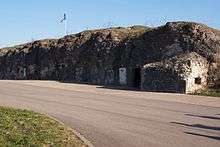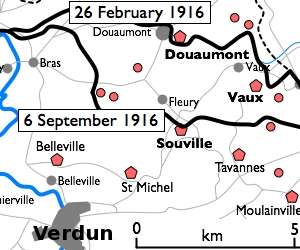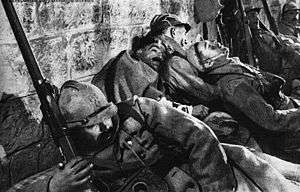Fort Vaux
Fort Vaux, in Vaux-Devant-Damloup, Meuse, France was built from 1881–1884 for 1,500,000 Francs and housed a garrison of 150 men. Vaux was the second Fort to fall in the Battle of Verdun after Fort Douaumont which was captured by a small German raiding party in February 1916, in the confusion of the French retreat from the Woëvre plain. Vaux had been modernised before 1914 with reinforced concrete top protection like Fort Douaumont and was not destroyed by a German heavy artillery-fire which had included shelling by 16-inch howitzers. The superstructure of the fort was badly damaged but the garrison, the deep interior corridors and stations remained intact when the fort was attacked on June 2 by German assault troops.
The defence of Fort Vaux was marked by the heroism and endurance of the garrison, including Major Sylvain-Eugene Raynal. Under his command, the besieged French garrison repulsed German assaults, including fighting underground from barricades inside the corridors, during the first big engagement inside a fort during World War I. The last men of the French garrison gave up after running out of water (some of which was poisoned), ammunition, medical supplies and food. Raynal sent several messages via homing pigeons (including the famous Vaillant), requesting relief for his soldiers.[1] During his last communications, Major Raynal wrote "This is my last pigeon".[2]
After the surrender of the garrison on June 7, the German army group commander Crown Prince Wilhelm, presented Major Raynal with a French officer's sword as a sign of respect.[3] Raynal and his soldiers remained in captivity in Germany until the Armistice of 11 November 1918. The fort was recaptured by French infantry on November 2, 1916 after an artillery bombardment involving two long-range 400 mm (16 in) railway guns. After its recapture, Fort Vaux was repaired and garrisoned. Several underground galleries to reach the far outside, one of them being 1 mi (1.6 km) long, were dug and equipped, the water reserve was quadrupled and light was provided by two electric generators. Some damage from the fighting on June 2 can still be seen. The underground installations of the fort are well-preserved and are open to the public for guided visits.
First World War

- September 11, 1914, turret 75 fires 22 shots at a German detachment in the Bois de Mabras.
- February 18, 1915, the fort is bombarded for the first time by twelve 420 mm rounds which causes little damage.
- End of 1915, progressive disarmament of the fort is carried out to send the guns and ammunition to the front-line.
- In January 1916, there is now enough gunpowder in stores for the possible destruction of the fort in case of an enemy approach.
- From 21 to 26 February 1916, the fort is bombarded with shells of all sizes including 129 large heavy shells. Pillboxes take damage, armoured observatories also take damage, command and will cut the gallery leading to the turret 75.
- Late February – early March 1915, the fort is frequently bombarded and turret 75 is destroyed accidentally by heavy shells that cause the explosives to blow it up.
- May 14, 1916, Commandant Raynal takes command of the fort, which has no artillery.[4]
- June 1, 1916, the Germans begin preparation for the invasion of the fort through the Bois de la Caillett. They cannot be stopped due to the fort having no artillery.[5]
- 2 and 3 June 1916, Germans attack the fort directly with flame throwers and force French troops outside to retreat into the fort. The Germans begin to enter the fort through the coffers of the contre-escarpe.[6]
- June 5, 1916, Commandant Raynal requests the French army to bomb the fort, where the top is taken over by the Germans, to allow a part of the garrison to evacuate the fort.[7]
- June 7, 1916, for three days water supplies are empty and the fighting takes place inside the galleries with grenades, guns and bayonets. Commander Raynal is captured by the Germans under military honours for having fought bravely in extreme conditions with a thirsty garrison.[8]

- From 8 June to 1 November 1916, the fort is used by the Germans as a shelter and command post for the area. The French attempt to retake the fort several times with enormous loss of life. They bombard the fort to destroy it with heavy shells, including 400 mm rounds, but the concrete walls resist. Life inside the structure becomes impossible and the Germans eventually abandon the fort at the end of October.[9]
- November 2, 1916, the fort is recaptured without resistance by a French patrol which finds it empty.[10]
- By the end of the battle, in December 1916, the fort is almost in the same condition as it was in June, except for some damage caused by French artillery.
- 1916–1918, the Casemates de Bourges are rehabilitated before being rearmed and an observatory along with an armoured command bunker are equipped with machine-guns. Further defences including machine-guns are fitted in place of the turret 75, to defend the area between the ravine and the village of Dieppe. Exits and entrances of the fort are equipped with masonry baffles, armed with machine guns and grenade launcher chutes. A network of tunnels 17 m (19 yd) long is dug beneath the fort and generators are used for lighting and ventilation of the premises.[11]
Footnotes
- ↑ MINDEF/SGA/DMPA. "Le Vaillant and his peers". cheminsdememoire.gouv.fr.
- ↑ Holstein 2011, p. 63.
- ↑ Holstein 2011, p. 84.
- ↑ Holstein 2011, p. 44.
- ↑ Holstein 2011, pp. 46–49.
- ↑ Holstein 2011, pp. 50–66.
- ↑ Holstein 2011, pp. 66–74.
- ↑ Holstein 2011, pp. 76–84.
- ↑ Holstein 2011, pp. 84–93.
- ↑ Holstein 2011, p. 93.
- ↑ Holstein 2011, pp. 94–95.
References
- Binois, L.; Kaluzko, J.-L. (2003). Vaux, histoire d'un fort: la construction du fort de Vaux et les événements de 1916 [Vaux, History of a Fort: The Building of Fort de Vaux and the events of 1916] (in French). Louviers: Ysec Editions. ISBN 978-2-84673-028-0.
- Bordeaux, H. (1917). The Last Days of Fort Vaux, 9 March – 7 June 1916. Translated by Cohn, P. V. London: T. Nelson and Sons. OCLC 8701078. Retrieved 25 March 2016.
- Holstein, C. (2010) [2002]. Fort Douaumont. Havertown: Pen and Sword. ISBN 978-1-84884-345-5.
- Holstein, C. (2011). Fort Douaumont (pbk. ed.). Barnsley: Pen and Sword. ISBN 978-1-78303-235-8.
- Le Hallé, G. (1998). Verdun, les Forts de la Victoire [Verdun, the Forts of Victory] (in French). Paris: Citédis. ISBN 2-91192-010-4.
- Verdun and the Battles for its Possession. Clermont Ferrand: Michelin and Cie. 1919. OCLC 654957066. Retrieved 25 March 2016.
External links
| Wikimedia Commons has media related to Fort Vaux. |
- Les forts Séré de rivières Le fort de Vaux (in French)
- Memoirs & Diaries: Account of the assaults upon Fort Vaux, Verdun, June 1916

